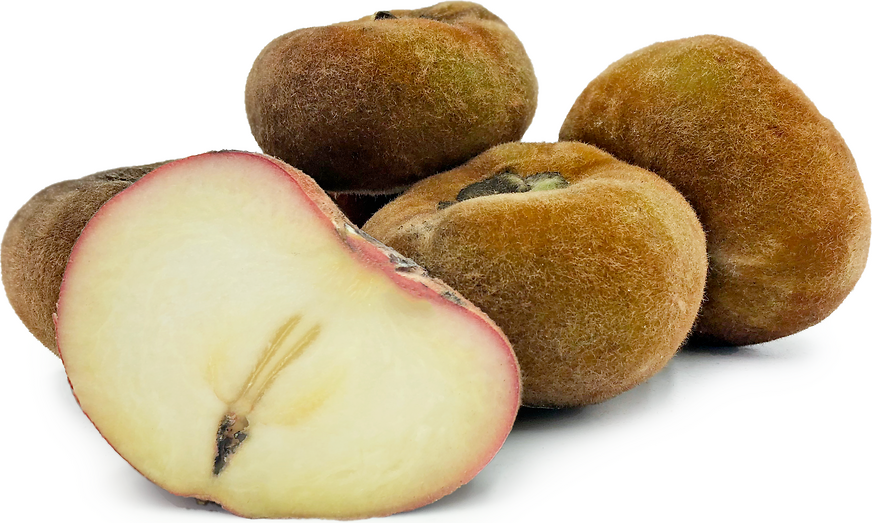


Velvet Apple
Estimated Inventory, lb : 0
Description/Taste
Velvet Apples range in color from golden-yellow to orange and purplish-red. They have a darkened, permanent calyx at the stem end, and are covered in tiny, brown hairs. Seedless varieties have a short, squat shape, like a persimmon, whereas varieties with seeds are more rounded. They can develop flat spots due to growing in tight clusters of two to four fruits, and can be anywhere from 5 to 10 centimeters wide. The skin is thin and can be tough and bitter and is generally discarded. In some varieties, the skin may have an unpleasant aroma that will dissipate once it’s removed. The white to off-white flesh is crisp when mature and will soften slightly as it ripens. The taste is sweet, and the flavor has been likened to banana-flavored apples or strawberry-mango yogurt with hints of berries and bubblegum. Darker, red fruits are considered sweeter than lighter colored varieties.
Seasons/Availability
Velvet Apples are available year-round with a peak season during the summer months.
Current Facts
Velvet Apples, are a tropical fruit related to the persimmon, in the Ebenaceae or Ebony family, though they are more closely related to the black sapote. Botanically, they are classified as Diospyros blancoi and are sometimes referred to as the Velvet persimmon. In Tagalog, the fruit is called Kamagong, and it is also known as Mabolo, the word for hairy.
Nutritional Value
Velvet Apples are a good source of calcium, and potassium. They also contain vitamins A, C, and B-complex vitamins, iron, dietary fiber and some protein. Studies have demonstrated that compounds in Velvet Apples offer anti-inflammatory properties.
Applications
Velvet Apples are most often eaten raw, the flesh scooped from the halved fruit. Fruits can be sliced or quartered and topped with lemon or lime juice. The flesh can be mixed with other tropical fruits for salads or desserts. The flesh can be pureed and used for desserts or beverages. Velvet Apples can be dried and preserved. If boiled or stewed the flesh will become tough. Immature, firmer fruits can be sautéed or fried and served alongside meats as a vegetable. Store Velvet Apples in the refrigerator for up to a week.
Ethnic/Cultural Info
In the Philippines and Taiwan, the wood of the Velvet Apple tree is considered valuable and is prized for its dark color, strength and durability. It is known as Kamagong wood, or “Iron Wood” and sometimes Philippine or Taiwan Ebony. The wood is used for making utensils, hair combs, beads for necklaces and jewelry.
Geography/History
Velvet Apples are native to the tropical forests of the Philippines and Taiwan. They were introduced to the islands of Java, Malaya and Singapore in the late 1800s and to the United States in 1906. Trees were planted in Miami, where they thrived, and were later introduced to the island of Bermuda and then Cuba. Today, they are primarily found growing in Indonesia, Malaysia, Sri Lanka, Singapore, India, Bangladesh, and to a lesser extent in Australia, Hawaii, and Key West, Florida. Velvet Apples may be spotted at local farmer’s markets.
Recipe Ideas
Recipes that include Velvet Apple. One
| Living a Delicious Life |
|
Velvet Apple (Mabolo) Smoothie |




